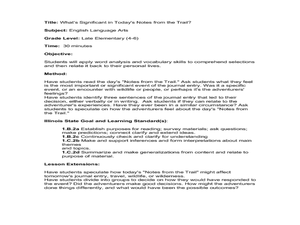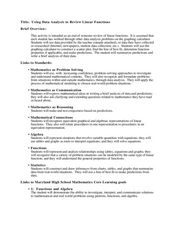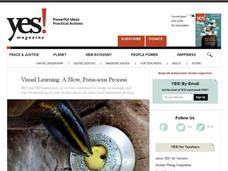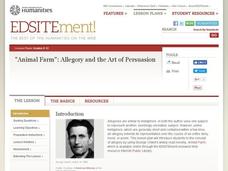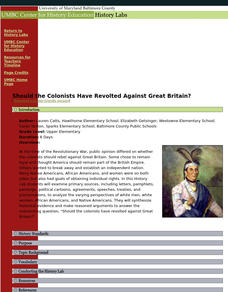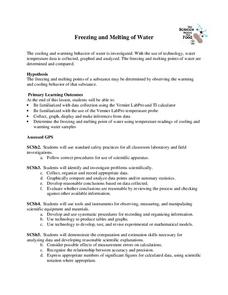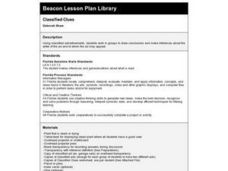Curated OER
Ooblek
Learners demonstrate the three states of matter. In this matter lesson, students read Bartholomew and the Ooblek. Learners create "ooblek" and discuss what state of matter it is.
Curated OER
Getting Ready to Become An Adult
Students participate in a problem solving activity and discuss how effective their solution was. For this getting ready to become an adult lesson, students read Ta-ne-e-ka and use guiding questions to address the relationships in...
Curated OER
50th Anniversary of Brown v. Board of Education
Young scholars examine a poster of Brown v. Board of Education and discuss what the important details are. They read the story behind the poster and court case. They role play different sections of the case such as the court case or...
Curated OER
Cities and Seasons
Students explore how satellite images show seasonal changes in seven cities in North and South America. Through a sequence of images, they study the green-up and brown-down of the seasons and how seasons change over time. Afterwards,...
Curated OER
What's Significant in Today's Notes from the Trail?
For this instructional activity, you will need access to "Notes from the Trail." Your learners will read the day's text, and identify the most important or significant event in the journal entry. Not many prompting questions are...
Curated OER
Design Your Perfect Career
Students incorporate the design process to create their own perfect job or career. In this career design instructional activity, students develop questions to research for a future career choice. Students brainstorm about their personal...
Curated OER
Using Data Analysis to Review Linear Functions
Using either data provided or data that has been collected, young mathematicians graph linear functions to best fit their scatterplot. They also analyze their data and make predicitons based on the data. This instructional activity is...
Curated OER
Visual Learning: A Slow, Press-ious Process
Students observe a photograph and make inferences. In this investigative lesson students study how to find facts in pictures and draw inferences from them.
UAF Geophysical Institute
System Interactions: The Lorax and the Truffula Tree
If the Lorax were to write a letter, what would he write? Introduce your class to systems and feedback loops through the whimsical stylings of Dr. Seuss. Learners take on the Lorax's point of view to write a letter, among other activities.
National Endowment for the Humanities
Animal Farm: Allegory and the Art of Persuasion
Introduce your class members to allegory and propaganda with a series of activities designed to accompany a study of George Orwell's Animal Farm. Readers examine the text as an allegory, consider the parallels to collective farms...
Maryland Department of Education
A Raisin in the Sun and Dreams Deferred
To conclude a study of A Raisin in the Sun and to prepare for a visit to the Lewis Museum, class members analyze Langston Hughes' poem "Harlem." Learners then draw connections to characters in the play and to their own experiences...
Center for History Education
Should the Colonists Have Revolted Against Great Britain?
Should the Americans have taken the plunge and revolted against Great Britain? Using documents, including the famed Common Sense and a Loyalist response, pupils conduct a lengthy investigation of the question. The interesting resource...
University of Georgia
Freezing and Melting of Water
Examine the behavior of energy as water freezes and melts. An engaging activity provides a hands-on experience to learners. Collaborative groups collect data and analyze the graphs of the temperature of water as it freezes and then...
Curated OER
Classified Cues
Learners analyze classified advertisements to make inferences about who wrote the ad and who may find the ad appealing. They write their own classified ads based on what they have learned.
Curated OER
From Seeds to Plants
Second graders review the process of plant reproduction and the role of seeds in that process. The students dissect a seed, analyze their finds, collect and record data, and make predictions about seed germination and plant growth.
Curated OER
Magazine Madness
Learners look at pictures cut out of magazines to determine what is happening in the picture and predict what will happen next.
Curated OER
Reflections on Poetry Readings
Eighth graders design and compile a booklet of published and original poems reflective of a specific theme.
Curated OER
Archaeology of the Future
Students view pictures of classmates' homes, make list of different objects in picture, and discuss what they can tell about place from evidence in picture. Students then observe artifact pictures, and read and complete artifact chart.
Curated OER
"Julie of the Wolves"
Fifth graders research life in Alaska and compare life there to their lives in this lesson. They read "Julie of the Wolves." They research through the novel and other reference books facts about the Alaskan climate and geography. They...
Curated OER
Enrichment Activities - "Mrs. Frisby and the Rats of NIMH"
Fifth graders read the novel "Mrs. Frisby and the Rats of NIMH." They discuss the various characters in the book, and the different types of conflict that take place within the book. They also research owls and rats to make comparisons...
Curated OER
Archeology of the Future
Students are introduced to the basic vocabulary of archeology. Using the vocabulary, they classify artifacts and make inferences about their uses. In groups, they create a chart for the criteria needed to analyze artifacts and share...
Curated OER
One Big Happy Family
Young scholars will explore the role and structure of the family in the target culture and the relationships among family members. The skills help learners make connections to language because the information of the lesson plan uses...
Curated OER
ReQuest and Motor Imaging with My Side of the Mountain
Fifth graders read "My Side of the Mountain." They create a pantomime using vocabulary words from the story. Students create three questions about the reading. They discuss the passage they read and act out words to help them better...
Curated OER
Mr. Cobbler's Shoe Dilemma
Students employ statistics to solve real-world problems. They collect, organize and describe data. They make inferences based on data analysis. They construct, read, and interpret tables, charts and graphs.






